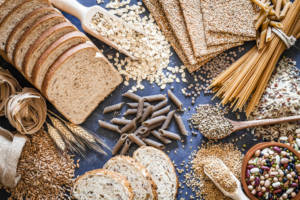
If a poor diet can help usher in type 2 diabetes, here’s some good news: a healthy high-fiber diet can help keep it under control.
In the last few decades, researchers have gotten a fix on what role specific foods might play in the development of type 2 diabetes. A six-year study reported in the Journal of the American Medical Association found that women who ate a high-sugar, low-fiber diet — including soft drinks, white bread, white rice, and mashed potatoes — were two-and-a-half times more likely to get diabetes than women who ate plenty of roughage.
Based on data from 65,000 women participating in the long-running Nurses’ Health Study at Harvard University, this was the first large-scale study to uncover a dietary link to diabetes.
Roughage lowers the need for insulin by slowing the absorption of carbohydrates, and preventing surges in blood sugar, scientists explain, while a sugary low-fiber diet is likely to induce a chronic demand for insulin. Over time, the pancreas can’t make as much insulin as people with this poor diet require. The resulting condition, known as insulin resistance, is the most common cause of type 2 diabetes.
“It appears that adult-onset diabetes is largely preventable,” says JoAnn Manson, MD, an endocrinologist at Brigham and Women’s Hospital in Boston. “In our studies, we’ve found that 80 percent of adult-onset diabetes is linked to excess body weight. This is one case where heredity is not destiny.”
Biology is not destiny
Another study unveiled at one of the American Diabetes Association’s annual conferences supports Manson’s statement. An active lifestyle and healthy meals can greatly lower genetic susceptibility to diabetes, according to researchers at the National Institute of Diabetes and Digestive and Kidney Diseases.
They discovered that the prevalence of diabetes among Mexican Pima Indians, who do heavy labor and eat a traditional diet of low-fat unprocessed foods like beans and handmade corn tortillas, was almost one-sixth of the rate of Arizona Pima Indians, who tend to be sedentary and favor high-calorie high-fat Western convenience foods such as hot dogs.
The Arizona Pimas have one of the highest rates of diabetes in the world. Fifty percent of tribe members between the ages of 30 and 64 have type 2 diabetes.
“Our results show that having a genetic predisposition to the disease doesn’t mean that you’ll develop type 2 diabetes,” says Leslie Schultz, a nutritional biochemist with the University of Wisconsin in Milwaukee who worked on the study. “If you can control your lifestyle, you can control, to a large extent, whether or not you develop the disease.”
More fiber, less diabetes?
Since Manson’s study, other scientists have done further research on the theory that fiber-rich foods may help prevent type 2 diabetes. A small study published in the New England Journal of Medicine reported that people with diabetes who eat more high-fiber grains, vegetables, and fruit can better their blood sugar and possibly avoid the need for additional diabetes medicine.
During the study, 13 patients with type 2 diabetes spent six weeks eating 24 grams of fiber a day (nutritionists generally recommend 20 35 grams per day). They then upped their intake of fiber to 50 grams for the next six weeks. (Among the foods added to their diets were papaya, oranges, grapefruit, sweet potatoes, raisins, granola, oat bran, and oatmeal; unlike subjects in similar studies, they didn’t take any fiber supplements.) Not only did the patients see striking improvement in their blood sugar levels, they found their cholesterol levels improved as well.
Endorsing the study’s findings was the Joslin Diabetes Center, a leading diabetes research institution. Joslin recommends diabetics consume a minimum of 20 to 35 grams of fiber a day. Joslin officials cautioned, however, that diabetics should add fiber to their diets gradually (about 3-5 grams a day) to prevent bloating. They also advised drinking at least 8 cups of liquid (besides those containing caffeine or alcohol) to ward off constipation.
Exercise improves insulin resistance
And several studies have bolstered the theory that getting exercise may fend off diabetes in those at risk. The New England Journal of Medicine, for example, published a study by researchers at Yale University School of Medicine showing that after six weeks of moderate exercise, 10 adult children of diabetics — all sedentary but not overweight and all suffering from insulin resistance — significantly improved their sensitivity to insulin.
Letitia Thomas knows well the value of regular workouts and smart food choices in high-risk people like herself. Thomas, a study coordinator at Johns Hopkins University in Baltimore, is an African-American and mother of two boys; her brother, mother, and maternal grandmother all have diabetes. Thomas herself had gestational diabetes during her two pregnancies, and most of her life she has struggled in vain to lose weight. “I [thought] I couldn’t escape the disease,” she says. “And I was afraid.”
But rather than resigning herself to failing health, Thomas decided two years ago to do something about the risk factors she could control. At that time she hit the scales at 234 pounds. She sized up her diet — heavy on fatty foods such as fried chicken and hamburgers — and her exercise routine — nonexistent — and set about changing her ways.
Walking, aerobics, and working out on a treadmill are now part of her daily schedule. And she prepares low-fat meals, mostly salads, what her husband used to teasingly call “rabbit food.” To date she dropped 47 pounds; she aims to shed another 30.
Thomas’s husband recently learned he has diabetes, strengthening his wife’s resolve to stop the disheartening cycle. She knows that to stand a decent chance of averting the disease, she’ll need to stick with her new habits for a lifetime. But she’s willing to try — and not just for her own sake. “I don’t want to push this on my kids,” she says. “Three generations is enough.”